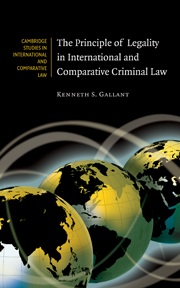Book contents
- Frontmatter
- Contents
- Explanatory Note on Spelling
- Acknowledgments
- Introduction
- 1 Legality in Criminal Law, Its Purposes, and Its Competitors
- 2 A Partial History to World War II
- 3 Nuremberg, Tokyo, and Other Postwar Cases
- 4 Modern Development of International Human Rights Law: Practice Involving Multilateral Treaties and the Universal Declaration of Human Rights
- 5 Modern Comparative Law Development: National Provisions Concerning Legality
- 6 Legality in the Modern International and Internationalized Criminal Courts and in the UN Trust Territories
- 7 Legality in Customary International Law Today
- Conclusion: The Endurance of Legality in National and International Criminal Law
- Appendix A Chart of Non-retroactivity Provisions in Criminal Law by Nations
- Appendix B Legality and Non-retroactivity Provisions as of 1946–47
- Appendix C Constitutional and Other National Provisions Implementing the Principle of Legality Today
- Bibliography
- Table of Authorities
- Index
- Afterword and Update
- CAMBRIDGE STUDIES IN INTERNATIONAL AND COMPARATIVE LAW
Appendix B - Legality and Non-retroactivity Provisions as of 1946–47
Published online by Cambridge University Press: 04 July 2009
- Frontmatter
- Contents
- Explanatory Note on Spelling
- Acknowledgments
- Introduction
- 1 Legality in Criminal Law, Its Purposes, and Its Competitors
- 2 A Partial History to World War II
- 3 Nuremberg, Tokyo, and Other Postwar Cases
- 4 Modern Development of International Human Rights Law: Practice Involving Multilateral Treaties and the Universal Declaration of Human Rights
- 5 Modern Comparative Law Development: National Provisions Concerning Legality
- 6 Legality in the Modern International and Internationalized Criminal Courts and in the UN Trust Territories
- 7 Legality in Customary International Law Today
- Conclusion: The Endurance of Legality in National and International Criminal Law
- Appendix A Chart of Non-retroactivity Provisions in Criminal Law by Nations
- Appendix B Legality and Non-retroactivity Provisions as of 1946–47
- Appendix C Constitutional and Other National Provisions Implementing the Principle of Legality Today
- Bibliography
- Table of Authorities
- Index
- Afterword and Update
- CAMBRIDGE STUDIES IN INTERNATIONAL AND COMPARATIVE LAW
Summary
The following materials on the status of legality and non-retroactivity provisions come from the Documented Outline prepared by the Secretariat for the Commission on Human Rights Drafting Committee for the International Bill of Rights, UN Doc. E/CN.4/AC.1/3/Add.1, pp. 215–34 (2 June 1947) (sources for Articles 25 and 26) and the first [UN] year book on human rights 1946 [hereinafter 1946 UNYBHR], which was designed to “‘include all declarations and bills on human rights now in force in the various countries.’” The Documented Outline included constitutional provisions of UN member states. The 1946 UNYBHR included constitutional provisions of UN member states; where no human rights provisions existed in the relevant constitutions, it sometimes included statutory provisions and in some cases materials from experts describing the law of the jurisdiction; there were also provisions from non–member states.
This material represents a good snapshot of the constitutional law of legality as of 1946, and a very incomplete view of statutory and other law. The UN member constitutions represent material that was available to the drafters of the UDHR as well as those involved in the early stages of drafting the ICCPR. The other material in the 1946 UNYBHR would have been available by 1948, though it is less easy to say how much of it was actually used by the delegates who participated in drafting the UDHR and the later ICCPR.
The material excerpted here only concerns issues of legality in criminal law.
- Type
- Chapter
- Information
- Publisher: Cambridge University PressPrint publication year: 2008

